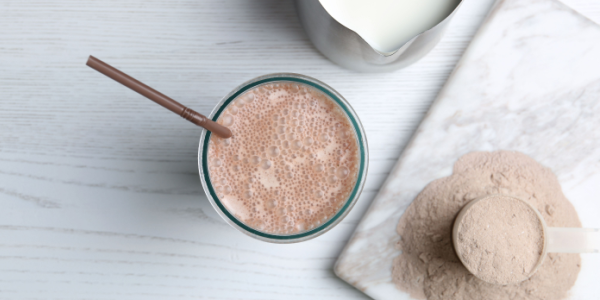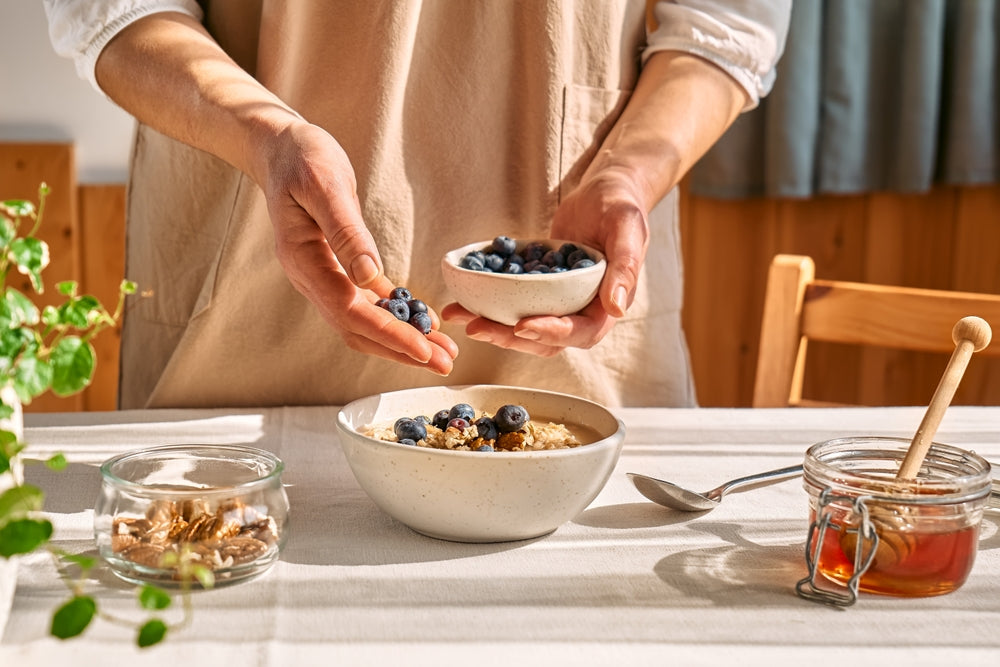
Are protein shakes good for weight loss? Many wonder, and few may know the details.
The good news: Having extra protein in the diet can hasten your health goals. However, as with any nutrient, paying attention to your protein supplement’s quantity and quality is important to keep your weight loss goals on track.
Keep reading for tips on using protein shakes and powders to empower weight loss.
Are Protein Shakes Good for Weight Loss?
Protein supports adapting metabolisms, muscle repair, growth, and other crucial body functions. So, it makes sense that protein shakes would be implicated in weight loss—when you want to preserve or build muscle while shifting your metabolism to burn more fat.
Surprisingly, protein shakes can be utilized for a variety of goals. Some people drink protein shakes for weight loss, and others for weight gain (like in older adults with appetite problems). Luckily, protein shakes can be tailored to your unique dietary needs and health goals, depending on how you use them.
While scientists are still trying to fine-tune which mix of proteins and amino acids is optimal for weight loss, both protein quantity and protein quality have been shown to play an important role in regulating metabolism.
Whey protein is promising. Studies have shown that it can improve indicators of body composition, especially when combined with other healthy habits—like regular resistance training exercises and careful attention to calories.
Research also suggests that adhering to a high-protein diet—with at least 1.4 grams per kilogram (g/kg) body weight—may promote greater weight loss than simply eating a standard protein diet (0.8 g/kg body weight).
What Are Protein Shakes?
To understand protein shakes, looking at protein powders is first helpful. Protein powders are concentrated, powdered forms of protein. They are usually made from various high-protein foods, including animal sources (like whey) and plant sources (like pea protein).
Homemade protein shakes often use protein powder to create some sort of drink, usually with water or milk mixed in. Store-bought options are similar but typically come premixed and can contain added vitamins and minerals.
Purpose of Protein Shakes
As mentioned above, protein shakes are used for a variety of purposes. They are often used as a protein supplement to ensure an individual gets enough protein each day to meet nutritional needs and overall health goals. Protein shakes may also be used for people with higher protein needs, such as older adults, athletes, or people with certain health conditions.
Some people find it difficult to consume adequate amounts of protein each day, which means they may not be getting enough essential amino acids—the “building blocks” of protein that the body can’t make on its own and must be obtained from food. A protein shake can act as an insurance plan that fills nutritional gaps and assists you in meeting daily protein requirements.
Since plant-based options are available, protein shakes can be vital to plant-based diets. Plant-based protein powders may allow vegetarians and vegans to obtain nutrients and amino acids they may not be getting otherwise due to a lack of animal protein in the diet.
Uses for Protein Shakes
Among athletes or people pursuing weight loss, protein shakes promote muscle growth. Protein doesn’t just build muscles but also contributes to maintaining and repairing them.
Shakes are also used more casually by health-conscious folks as a convenient option for when life gets busy. Many protein shakes can be stored easily in the pantry or fridge until ready to be used. They are also a great option to have on hand for people who struggle to eat breakfast in the morning but want a boost of protein at the beginning of the day.
Additionally, protein shakes provide alternate sources of protein for people struggling with a conventional diet for any of the following reasons:
• Changes in or loss of appetite
• Chewing difficulties
• Food aversions (such as during pregnancy)
• Illness, injury, or infection
• Surgery or recovery
Types of Protein Shakes
The types of protein shakes and powders are almost as vast as their potential uses! Each type of protein powder comes with a unique nutritional profile aside from being similarly high in protein. Common protein powders and protein shake bases include:
• Casein protein
• Hemp protein
• Pea protein
• Soy protein
• Whey protein
Most of the protein powders and drinks on the market contain whey protein, although plant-based sources are becoming more popular. Blends of several protein sources or powders are also fairly common.
How to Use Protein Powder and Shakes for Weight Loss
Protein shakes can be a key part of your weight loss diet, especially if you struggle to obtain enough protein from your foods. As with any supplementary food, it’s recommended to involve your healthcare providers in your decision if you plan to use protein shakes regularly.
Ensure Adequate Protein
Although the amount of protein considered “adequate” depends on your age, gender, and health status, the general rule of thumb for adults aiming to lose weight is 0.8–1.2 g/kg of body weight. Eating this daily can ensure you get enough protein to promote weight loss. For athletes, requirements are higher, ranging from 1.2–2.0 g/kg body weight.
A doctor or dietitian can help you calculate your protein needs, which can be helpful when choosing between protein shake products. Essentially, you’ll want to estimate how much protein you already get from your diet and how much may be lacking. Then, you can shop around and select a product to fill in the “gaps.”
Remember, you may not need a protein shake every day, but it can be beneficial to keep them stocked as a “backup” option (just in case).
Consider Both Quantity and Quality
Beyond getting enough protein, search for high-quality protein. Not all protein shakes are created equal, so it’s always worth the extra time it takes to examine the nutrition facts panel and ingredients list.
In general, high-quality proteins will be transparent about their protein source and how it’s processed. Instead of proprietary blends and excess added ingredients—like added sugars, fillers, flavorings, and dyes—high-quality powders and shakes should contain mostly ingredients from whole foods.
You’ll ideally want a complete protein powder that provides all essential amino acids, over incomplete protein powders, which lack all essential amino acids. Generally, whey and animal-based powders are complete proteins, whereas plant proteins tend to be incomplete (like plant-based proteins). Pea and soy-based proteins tend to be the exception, although blended plant-based powders can ensure a more comprehensive amino acid profile.
Use Sparingly as “Meal Replacements”
Like other weight loss drinks, protein shakes shouldn’t be the only protein source in your diet. Although many are described or labeled as “meal replacements,” they shouldn’t be used to replace every meal. Instead, they should supplement healthy habits you’re already taking part in.
Moreover, protein powders themselves aren’t well-balanced and fall short of carbs and fats. Not only does this mean missing out on key nutrients, but can make them unsatisfying.
For many people, having a “why” in mind allows them to use protein shakes mindfully. For instance, if your “why” behind drinking protein shakes from time to time is to satisfy cravings and encourage a feeling of fullness, you may be less likely to just grab one out of habit.
In essence, protein shakes should promote a healthy relationship with food and support you in keeping in touch with your body’s natural cues instead of encouraging unhealthy habits.
Time With Exercise
Along with your weight loss plan, it may be advantageous to time your protein intake with exercise. Within two hours after exercise, known as the “early recovery phase,” consuming protein during this time frame can improve muscle strength and mass. Eating or drinking protein may also reduce muscle protein breakdown and promote muscle building during this phase.
For this reason, some dieters prefer to limit protein shakes to their workout regimen rather than use them as a regular part of their meal planning (although they can still have their time and place). Some experts suggest using protein shakes only when pursuing certain health goals, such as building muscle, but not relying on them otherwise (as long as your diet provides enough protein).
Discuss Concerns with Dietitian
If you’re concerned or worried about incorporating protein supplements into a balanced diet, consult a registered dietitian about how to use protein shakes and powders healthily. As diet experts, dietitians can also counsel you on supplementary foods and supplements.

Dietitians are privy to smart solutions, like bistroMD protein shakes, that can help you make the most of your nutrition plan (even when you’re short on time or other resources).
Drawbacks of Protein Shakes Weight Loss
A high-protein diet, supplemented with protein shakes, isn’t a perfect fit for everyone since diets aren’t a “one-size-fits-all” for health or weight loss. It’s recommended to have your weight management or weight loss plans personalized by healthcare providers.
Remember that protein supplements aren’t necessary for weight loss and may even be dangerous for certain individuals, especially when unregulated products come into play. Some downsides of protein shakes may sway you to get protein from food instead.
Imbalanced On Its Own
In general, dietitians recommend aiming for a “foods first” approach, where you try to obtain your protein from foods first before supplementing with protein shakes. This is because protein shakes aren’t a complete or balanced meal.
You’ll likely need to add some quality carbohydrates and healthy fats on the side when some people consider it less convenient than a grab-and-go shake. However, many convenient options balance the protein shake, like a piece of fruit and a smear of nut butter or a slice of toast with sliced avocado. Simp
Equating High-Protein to Low-Calorie
If you want to lose weight, remember that high protein doesn’t necessarily mean low-calorie. Regularly consuming protein shakes may lead to weight gain if you aren’t examining the entire nutrition label.
Fortunately, protein shakes with lower glycemic loads are thought to be better for blood sugar, weight loss, and heart health in general.
Products Can Be Pricey
One of the major drawbacks of protein shakes and powders is that they can be pricey, especially if you rely on them long-term. For reference, a serving of beans from the can usually cost less than $0.50-$1.00, while a serving of protein shakes or powder can cost over a dollar daily.
This can add up over time, making plain high-protein foods more affordable for frugal shoppers. To make a protein-powered beverage, you can still add many high-protein foods (like peanut butter and chia seeds) to a morning smoothie or shake.
If your heart is set on trying or using protein powder weekly, buying a single-serving protein powder packet may be worth buying. Doing so allows you to test out different types until you find your favorite and can encourage you to limit your protein powder intake to a manageable level.
May Not Satisfy Appetite or Texture Preferences
Some people find that protein shakes fill them up too quickly, making it difficult to obtain enough of other healthy foods in their meals. For others, protein shakes may need to fill them up more.
Additionally, the texture of protein powders and shakes isn’t universally appealing. Protein powders can be chalky, making them unpleasant to ingest for certain people. Instead of forcing yourself to use these products, you can shop until you find one you like (or simply forgo protein shakes altogether).
May Contain Unregulated Substances or Allergens
Unfortunately, like many supplements, the protein supplement market is largely unregulated. Although the Food and Drug Administration (FDA) technically oversees protein powder and shake brands, it’s difficult for the organization to keep tabs on all companies unless a big scandal is reported—being informed is key.
By nature, protein powders and drinks are considered “processed “products. Not all processed products are bad, but protein powders and shakes are more filled with contaminants and additives like added sugars. Some protein powders and shakes also contain common allergens (like soy), which may not be suitable for everyone.
Additions like branched-chain amino acids (BCAAs) may sound enticing but haven’t necessarily been proven efficient or consistent in their effect. Be wary of “too good to be true” health claims!
Overconsumption of Protein
Although eating too much protein is rare, relying on protein shakes for most of your meals or protein intake may lead to excessive protein intake. Ultimately, this can cause dysfunction in the body, creating symptoms you’ll need to find a different solution.
Remember that protein powders contain about 20 grams per serving (usually 1-2 scoops of powder or 1 protein shake bottle). You may meet around a third to half of your protein requirement by the end of breakfast if you have a protein shake in the morning, so plan the rest of the day’s intake accordingly.
Protein Shakes for Weight Loss: Final Thoughts
Individuals can meet recommended protein intake through food alone. However, protein supplementation through powders or shakes may be helpful, depending on your weight loss goals.
Working with a dietitian can be valuable in identifying any drawbacks and can be crucial to personalizing your protein shake intake to suit your overall nutrition plan.





